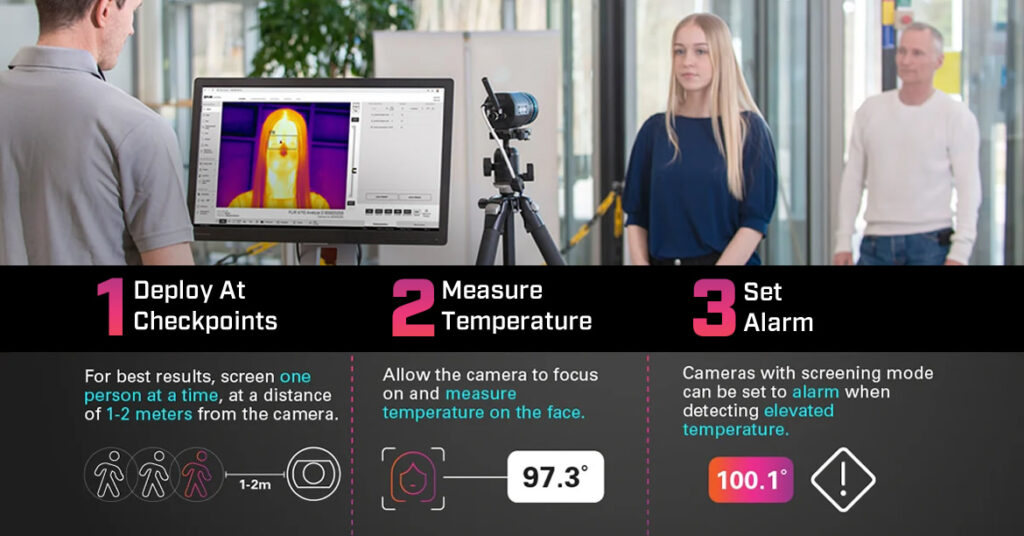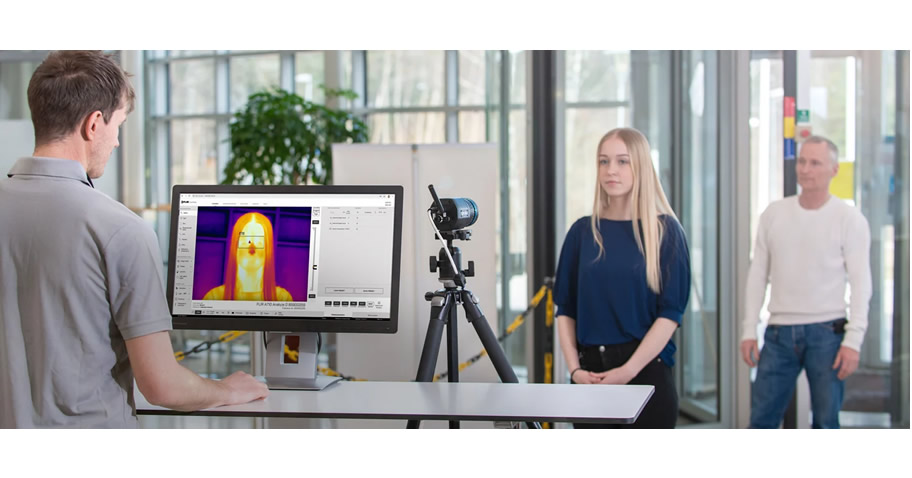FLIR thermal imaging cameras can be a useful, efficient tool for screening people for signs of elevated skin temperature (EST).

Unfortunately, not every thermal camera is appropriate to this application. Obtaining actionable data requires adequate thermal resolution and measurement accuracy, as well as the correct preparation and scanning methodology.
To help clarify the best practices for this non-contact screening option, FLIR offers these answers to frequently asked questions.
Q: Can FLIR products be used to detect a virus such as the Novel Coronavirus (COVID-19)?
A: No, thermal imaging cameras cannot be used to detect or diagnose an infection. However, FLIR thermal cameras are used today in public spaces such as airports and hospitals and by essential services such as manufacturing and shipping as an effective tool for measuring skin surface temperature. People who are identified as having an elevated skin temperature can then be screened by medical professionals using additional tools such as an oral thermometer.
Q: How does thermal imaging technology work?
A: FLIR thermal cameras detect heat radiation and can be used to identify the surface temperature of objects and people. With this capability, FLIR thermal cameras are commonly used as a non-contact screening tool to detect differences in skin surface temperatures and pattern changes. In fact, FLIR is registered with the US FDA to provide a variety of its thermal products to screen for elevated skin temperatures in connection with additional screening tools.
Q: How should operators use thermal cameras for skin temperature screening?
A: Here are several tips to ensure optimal measurement performance from a FLIR thermal camera:
- Camera operators should screen people one at a time to look for temperature anomalies.
- Camera operators should measure temperature at the tear duct (inner canthus) as this location provides the closest temperature correlation to human core body temperature.
- A camera operator who detects elevated skin temperature in a person being screened should request that such individual be screened using a device designed specifically for measuring body temperature, such as a thermometer.
Q: What Fixed Mount products does FLIR offer for EBT screening?
A: The following FLIR thermal cameras are registered by the US Food and Drug Administration to detect differences in skin surface temperatures:
Fixed-Mount Thermal Cameras
- FLIR A320 Tempscreen
- FLIR A300
- FLIR A310
- FLIR A315
- FLIR A325
- FLIR A615
- FLIR A400 (Advanced Smart Sensor configuration)
Q: What is Screening mode?
A: Certain FLIR cameras include a Screening mode that provides an alarm when an object or person is detected to have an elevated temperature compared against a sampled average temperature value. Screening mode is not an absolute temperature measurement. Activating the Screening mode will turn on a measurement box and screening data on the camera’s screen that includes:
- Sampled Average Temperature
- Alarm Temperature
- Measured Temperature
In Screening mode, the operator saves the skin temperature data from ten people at the testing location to set the Sampled Average Temperature. An Alarm Temperature is then set by the operator by applying a delta, which is typically between 1°C and 3°C, resulting in an alarm temperature that’s 1°C-3°C greater than the Sampled Average Temperature. Each person is then screened individually, and their Measured Temperature is compared against the Alarm Temperature.
The Sampled Average Temperature should be updated through the screening operation period. By doing this, Screening mode helps account for many potential variations during screening throughout the day, including fluctuations in average person temperatures due to natural environmental changes, like ambient temperature changes. Screening mode reduces the need for absolute accuracy throughout the day and even self-calibrates to remove potential errors in absolute accuracy from camera to camera.
Flir cameras that offer screening mode are highly stable at room temperature, which makes them well suited for this application.
The FLIR A320 Tempscreen Camera offers Screening mode.
Q: How close do you need to be to detect someone with an elevated temperature?
A: In order to obtain a good temperature reading, it is recommended that the intended target be as close to the camera as possible (with respect to the camera’s minimum focus distance). The location of the camera may require a different lens. For instance, if the operator wanted to place the camera at a significant distance, FLIR may recommend a telephoto lens. Therefore, distance to the target is an important consideration, as is focus.
It is important that the application be set up so that all intended targets are in focus during the screening process, thereby creating a good image. In addition to focus, a good image is dependent on several additional functions and settings, with certain functions and settings affecting the image more than others. Functions and settings that the operator needs to set and/or adjust include the following:
- Adjust the infrared camera focus
- Adjust the infrared image (automatically or manually)
- Select a suitable temperature range
- Select a suitable color palette
- Change the measurement parameters
- Perform a non-uniformity correction (NUC)
Q: How accurate are the thermal cameras?
A: FLIR thermal cameras “see” or detect the temperature differences with temperature measurements between -20°C and 2,000°C (-4°F—3,632°F). The standard FLIR product accuracy specification of ±2°C or 2% of the temperature reading at 30°C (86°F) ambient environment applies to all temperature ranges it measures and for the multiple applications for which it can be used.
FLIR thermal camera with Screening mode can achieve accuracies of ±0.5°C (0.9°F) at 37°C (98.6°F). This can be achieved by using the camera in a stable ambient environment, only looking at humans, and updating the reference samples according to the population being screened.
It’s important to note there are many factors that can affect the accuracy of thermal cameras, such as focus, distance, the emissivity* of the target, the ambient environment, and the speed at which the temperatures are acquired.
*A target’s emissivity is its ability to emit thermal radiation. For example, ceramic mugs, clothing, and even human skin have high emissivity, while polished metals have low emissivity.
Q: Do I need to use a black body for EST screening?
A: There are advantages and disadvantages to using a black body when screening for elevated skin temperatures. Including a black body in the camera’s field of view can improve the system’s performance in this application. FLIR thermal cameras support this configuration.
However, FLIR offers thermal cameras with temperature screening mode that don’t require the use of a black body. The handheld versions of these products are all inclusive, minimizing points of failure and maximizing flexibility and mobility. Screening mode also helps account for many potential variations during screening throughout the day, including fluctuations in an individual’s temperature due to natural environmental changes. Screening mode reduces variations in absolute accuracy throughout the day and even accounts for any potential variation in absolute accuracy from camera to camera.
In contrast, using a black body for elevated skin temperature screenings can create challenges. The first is the cost and complexity of including an additional piece of hardware in the solution. Black body integration into a system makes mounting, powering, and ultimately maintaining it more complex. Such an addition also introduces another potential point of failure into the overall solution.
Proper focus on the black body is essential to getting accurate measurements. For a black body to be effective, it must be mounted in the same plane as the person being screened. A black body that is significantly closer or farther than the person being screened will be out of focus and not function as an accurate reference source.
If ultimately the screening solution includes the use of a black body, FLIR recommends following these requirements, as set forth in ISO/TR 13154:2017:
- The camera of the screening thermograph should be positioned perpendicular, both horizontally and vertically, to the face of the individual being screened so that the inner corner of both eyes can be imaged simultaneously.
- The individual being screened and the external temperature reference source should be in the correct position and orientation relative to the camera for proper focal distance, depth of field and image capture. There should be a means of ensuring that the individual being screened is in this proper position, e.g. a stool, marks on the floor. Consideration should be given to individuals in wheelchairs.
- The backdrop behind the individual being screened and, when used, side screens should be thermally uniform, high emissivity (non-reflective in the IR spectrum) and light in color (visible spectrum).
- The operator should be positioned with a clear visual field of the individual being screened and the display of the screening thermograph. The operator may need to intervene to correct the individual’s position. The operator should also be positioned in such a way as to divert individuals to the secondary screening area when required.
- Operators should be assessed as to their ability to discern the colors of the rainbow scale of the screening thermograph.
Q: Do people using FLIR cameras need to be certified/trained to understand how to interpret the images and data?
A: FLIR recommends that thermal camera operators obtain at a minimum Level 1 thermal imaging certification through certified thermography courses such as the Infrared Training Center. This is not a medical training or medical certification, but it provides a baseline understanding in thermography. The Infrared Training Center offers more advanced training.
Q: Can you name some companies, organizations, and airports that have purchased your products?
A: While we cannot name specific customers or comment on current sales, we can say that our thermal cameras are used by customers at ports of entries and high-traffic locations in several countries, including the US, China, Hong Kong, Taiwan, Singapore, South Korea, Thailand, Philippines, and Malaysia.
Q: How long has FLIR been selling thermal cameras and non-contact thermometers for elevated skin temperature screening?
A: FLIR noted an increase in the use of thermal cameras for skin temperature screening during the SARS outbreak in 2003.
Source: FLIR.com